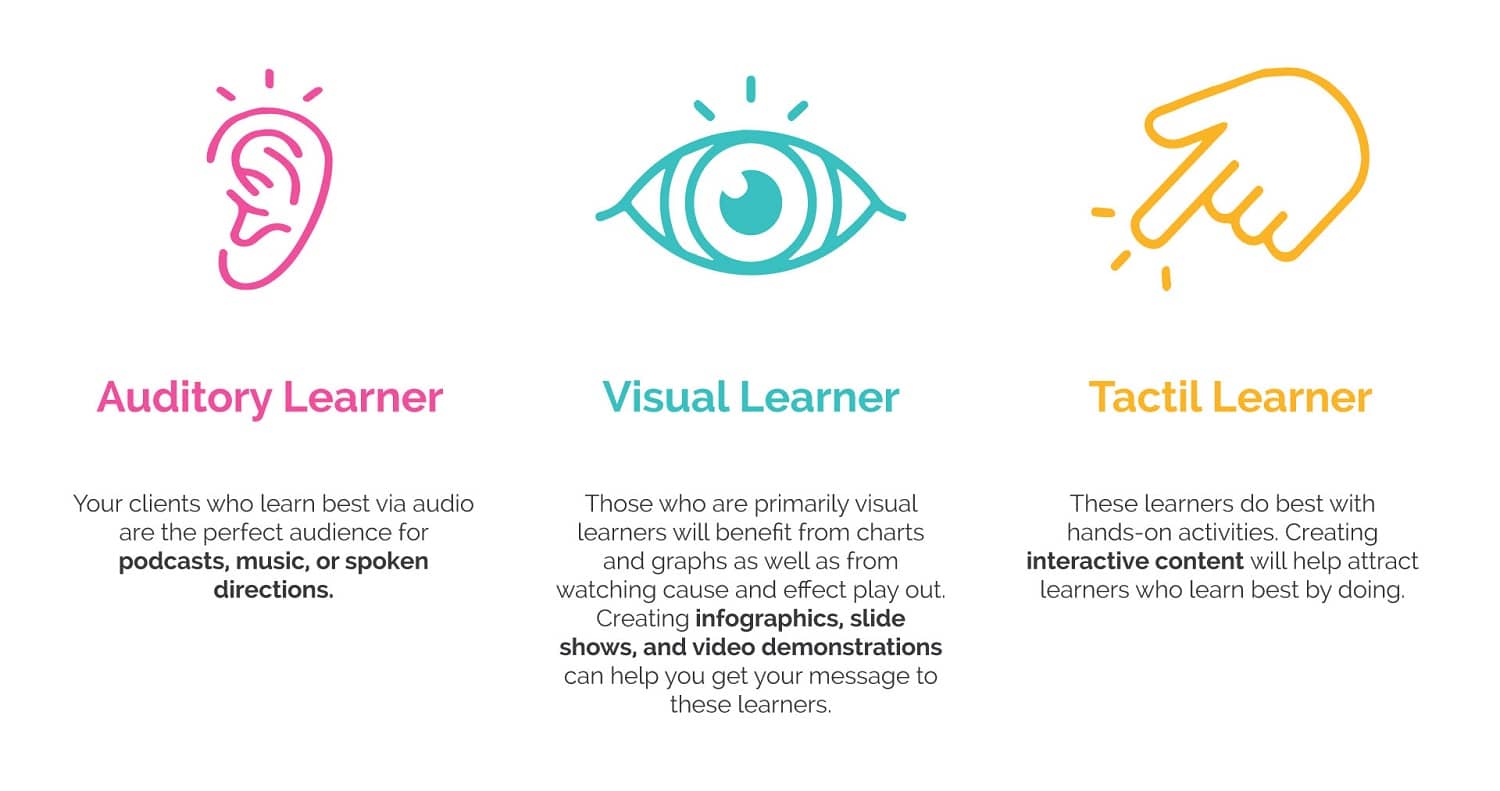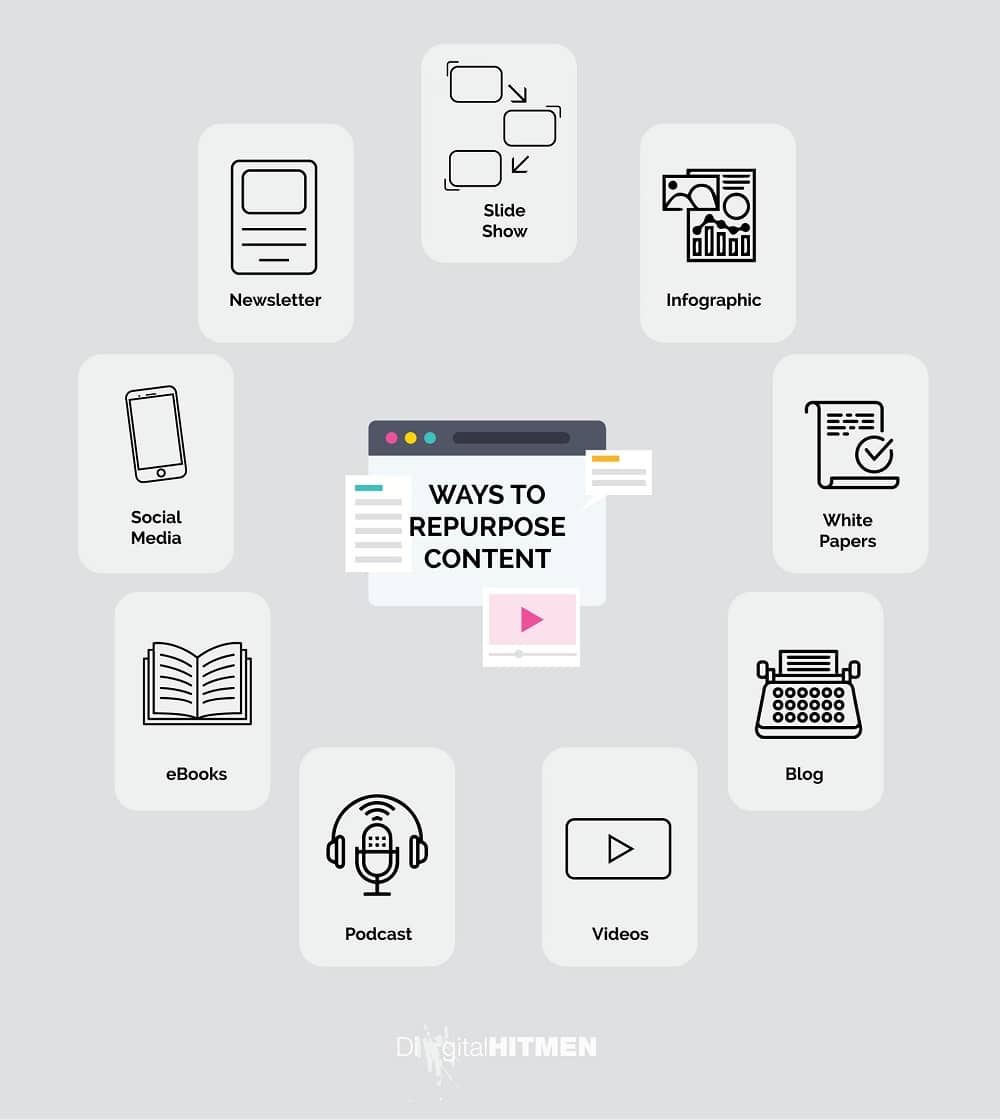It is no secret that excellent and engaging content is essential for your company’s SEO wellbeing. Right now, you may be sitting on months or possibly years’ worth of old blog posts, white papers, or infographics.
There is no doubt that some content loses relevancy over time. However, just like revamping last year’s runway fashions, all you need is the right material to start and some general skills to breathe new life into older content.
In this post, you’ll learn how to repurpose existing content on your website for a range of social media, SEO and brand awareness benefits.
What is content repurposing?
By definition, content repurposing (also called content recycling) is changing the format of parts of your existing content. Your goal is to expand the reach of work that is already complete.
For example, say you have a blog post that contains relevant graphs. One way to repurpose this would be to create an attention-grabbing Instagram post using updated graphics and the same content. Alternatively, let’s say you have several slides that have useful information. One way to repurpose the slides would be to fit them into a short YouTube video.
What content repurposing is not
Understanding what does not qualify as content repurposing is vital to success.
- Content repurposing is not merely a reposting of old infographics on a new social media platform or reading an old blog post on a podcast. Repurposing involves correct formatting and targeting when applicable.
- Content repurposing is not full-on revamping of your content. You are not aiming to add new research or change the focus of the material. You are taking current content and changing how and where it appears.
- Content repurposing is not a lazy technique to build your client base. It is faster than making new content from scratch, but it still involves thought, creativity, and know-how.
Why do I need to repurpose my content?
Several benefits come from repurposing your existing content. Some are relatively apparent such as saving time, effort, and money over starting from scratch. Other benefits are a bit less obvious:
- Increase your reach across social media platforms – When you venture out of your typical marketing routine, you may be amazed at the response you receive from unexpected places. For example, you own a garden centre and frequently create blog posts to educate your customers about techniques and best practices. What if you took some valuable dot points from a blog post on the correct way to prepare a raised vegetable garden and repurposed the information into an eye-catching and useful checklist for an Instagram post? Would you make an impact if you took the same dot points and created a YouTube video showing how customers can make the same garden at home?
- Improve your SEO and be seen as an authority in your niche – You know quality content can increase your site traffic, backlinks, SEO, and overall image as a site with authority. When you repurpose good content, you are multiplying the impact.
- Create an interactive online following – A small leap of faith, like a repurposing material into a how-to dog grooming video can turn into a series of videos, increased buzz about your abilities, and authority status in your area of expertise.
How do I know what content to use?
You should consider several factors when deciding what existing material you should repurpose. These include:
- It is crucial for you to use content that is evergreen (always relevant) when repurposing. Increasing the reach of facts or ideas that are not pertinent will at best accomplish nothing and at worst, make you seem out of touch to your clients.
- When choosing the content that you will repurpose, take the time to find some of your most popular and well-received content. You will start from a good point, and moving up is likely.
- Look for useful pieces of information within the existing material. When you are repurposing, you do not need to repurpose all of the data at once. Breaking up a blog post to go across several platforms is an excellent way to get all you can from one source.
- Take advantage of Google Analytics and YouTube Analytics data to help you determine which is your strongest and most popular content.
How do learning styles affect the outcome?
There is nothing new about meshing the science of human behaviour with marketing. So, it is natural to link the ways your customers learn and retain information with the repurposing platforms you try.
For ease of use, we can look at three primary learning styles. Remember that while people have a main type of learning, variations and overlapping are common.

Steps to repurposing content
If you are not familiar with the process of repurposing content, here are the first things to do to get started.
- Choose your highest-ranking relevant content to begin repurposing. Google Analytics is a quick way to discover your top content.
- Consider making a mind map to help brainstorm ideas for repurposing.
- Look for the best formats for repurposing your materials.
What are the best ways?
While there are a plethora of potential options for recycling content, let’s narrow the list down to our top 9.

1. Social media
Your most popular posts are proven hot topics for your target audience. And you can leverage that content to grow your social media engagement. The best part is you do not need to spend the majority of your time to create new content.
Here are some suggestions:
- Join the trend of social media influencers reusing their tweets for Instagram Stories and posts.
- Remodel your top content and convert them into quotes.
- Create trending memes, but make sure they match your brand voice and personality.
- Turn customer testimonials into social media posts.
- Transform webinars into social media video tutorials.
You can also try asking a thought-provoking question or simply add a clickable content title, which leads your audience to your evergreen post.
2. Newsletter
To get the most bang for your posts, why not promote them with a newsletter? The first step, though, is to have a solid list of subscribers that want to receive regular emails from you. We recommend implementing these email list building techniques.
Even your most dedicated fans will not notice your posts if you write several each day. This is where a newsletter comes in! Newsletters are a great way for your followers to catch every post you have.
A friendly and easy-to-read newsletter can help showcase your cream of the crop content. Also, you get to nudge your subscribers a little, so they go to your site. Don’t forget to include a link and use an attention-grabbing headline. This way, your readers will want to open your email.
3. Blog
You can republish content on other platforms, allowing you to repurpose your own blog posts into guest posts. You can also do the same for your blog, but be very careful. The original and the new version should be different from each other; otherwise, Google will penalise you.
If you plan to send your old posts to other sites, check that they have the same target audience as you. Make the content easy to read with headlines and dot points, especially if the original did not have them. Also, don’t forget to link back to your blog.
4. A slide show
When you have a large and somewhat cumbersome mountain of information, your reader may quickly become overwhelmed or uninterested. Creating a slide show gives you a chance to draw out the main points. Making your slide show is not difficult, but it requires a few steps.
- Trim the large chunks of data into manageable pieces.
- Place these pieces in an easy to view format with eye-catching (but not overdone) graphics or images.
- Arrange your slides into a sensible progression.
Blog posts, checklists, and longer video presentations adapt well into slide shows.
Your most popular posts are proven hot topics for your target audience. And you can leverage that content to grow your social media engagement. The best part is you do not need to spend the majority of your time to create new content.
5. Infographics
Turning your content into an infographic is a brilliant way to get your name and content in front of new eyes. Statistics show us that a useful infographic gets shared over three times more than other posts with similar content.
Infographics have a number of benefits, including:
- Easy to share on social media platforms.
- Generate backlinks by using embed codes.
- Effective for audience retention.
- Simple to promote across several sites using embed codes.
- Make large blocks of information manageable for your readers.
When creating your infographics, remember to include your company logo and opt for consistent use of colour. These simple tactics will help stamp your brand on your information as well as make the graphic memorable.
Slideshows, whitepapers, blog posts, and points of interest on a podcast all transform into quality infographics.
6. Podcasts
Podcasts appeal to a multitude of people across diverse age, socioeconomic, and cultural groups. The industry is hot and shows no sign of cooling.
However, the popularity of the medium does not offer a license to create shoddy podcasts. The mere fact that they are so many podcasts existing right now tells you to bring you’re a-game or do not step onto the field.

If you are new to the format, here are a few tips to help you create your podcast.
- Make a consistent framework for yourself regarding the mechanics of your podcast. What is your budget? Who is your target audience? Will you do one every week? Will the podcast air on the same day at the same time?
- Craft your content for a specific niche. You will be able to narrow your topics and offer pointed and dynamic content instead of watered-down broad-spectrum rambling. You will also get better results when you tailor your podcast to people who will benefit from your information.
- Start with a plan and stay with your plan. If you are going to talk about tactics to help a new puppy adapt to your home, do not wander off topic and discuss your dinner party invitations. While you do not want to mundanely read from a script, having an outline of the points you want to discuss is helpful if you do not focus well.
- Make your podcast between 15 to 30 minutes long. A shorter duration will not allow you to share much information, and listeners tend to tune out podcasts after 30 minutes.
- Engage with your audience. While not every listener wants to interact, many enjoy the experience.
- Invite a guest to speak with you. Adding another voice often makes conversations flow and holds listeners’ attention.
- Make sure you promote your podcast across as many platforms as is relevant. Form partnerships to cross-promote podcasts; if you are a dog trainer team up with a local pet shop or veterinarian for promotions, giveaways, and guest spots on podcasts.
- Enjoy yourself and your audience will find you authentic and will likely recommend your podcast to others.
Podcasts are great for sharing content from a wide variety of platforms. You can easily adapt points in an infographic, topics of a blog post, or information shown on a YouTube video to your podcast.
7. E-books
You can accomplish several objectives with e-books, depending on your goals. Creating an e-book and putting a nominal price tag on it can be a great source of revenue. Offering e-books as gifts to your customers is an excellent way to interact and build goodwill.
Regardless of your intent, there are a few vital facts you should know before you create your first e-book:
- You are creating a story, not a collection of blog posts from your site.
- Make sure your content is evergreen to get the most out of your e-books.
- Pay attention to details such as an attractive cover, headings, table of contents, numbered pages, and images. By all means, do not offer an e-book with poor grammar, spelling, or punctuation. Doing so will immediately lower your value in the eyes of many customers.
Most of your evergreen content can adapt to a useful e-book. If you have a large collection of related posts, consider offering a series of e-books instead of cramming the information into a single book.
8. Videos
Posting videos on YouTube is a popular way to engage with your audience as well as gain new clients. Additionally, video posts add to your SEO and get fresh eyes on your content.
Some well-received videos are frequently one of the following varieties.
- Training or teaching videos.
- Videos that explain concepts.
- News videos (though these may not stay evergreen or relevant).
- Short trailer videos to create buzz around your product or company. Here’s an example of ours:
[dt_fancy_image type=”from_url” image=”https://www.digitalhitmen.com.au/wp-content/uploads/2020/09/youtube-videos-repurpose-content.jpg” image_dimensions=”1200×672″ image_alt=”You can easily repurpose content using YouTube video” media=”https://www.youtube.com/watch?v=ti4MXAgUnyg?enablejsapi=1&rel=0&showinfo=1&mute=1&loop=1&modestbranding=1″ onclick=”lightbox” image_hovers=”false” width=”906″ border_radius=”0px” extra_class=”video-embeded-thumbnail”]
You can easily repurpose existing content to your audience using YouTube videos.
A bit of skill helps when creating a video to post. However, most written content converts into a video script nicely.
9. White papers
A great deal of your evergreen content will translate into a white paper that can serve you well and boost your image as an authority figure in your niche.
White papers are ideal for presenting the facts, figures, and percentages you accumulate doing research. Remember, your content must be fresh and relevant in a white paper. If it is outdated, your readers will not see you as an expert but as someone who just wasted their time.
Can any content be repurposed?
In theory, yes. However, it would be best if you resisted the temptation to repurpose all content without careful consideration. Be sure that what you are working with is still relevant. It does not necessarily have to be from one or two years ago, but the topic and information must apply to the here and now.
Beware of making something that seems like duplicate content. Also, avoid jumping on a well-worn bandwagon. Readers will tire of the same information even if it is said a different way. Focus on what makes you and your knowledge stand out from the crowd.
A word of caution
Repurposing your existing material is a timesaving endeavour. However, some effort is necessary to get a result that you are proud to post. Remember the revamping fashion analogy? You can place a plastic rain poncho over an Armani suit and have a new look, but it is not a look you would want to show to the world.
It is always a good time to roll out content that will entice and impress visitors to your website. Do not be afraid to try different platforms in an effort to build your customer base. An uninspiring block of text can become a top trending infographic with some repurposing.
If the idea of repurposing content sounds appealing to you, but you do not have the time to devote to the endeavour, consider reaching out to us. A professional’s touch can take acceptable material and transform it into amazing content.






